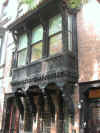 |
New York
Architecture Images-Greenwich Village Lockwood DeForest House |
||||
|
architect |
Van Campen Taylor | ||||
|
location |
7 East 10th Street. | ||||
|
date |
1887 | ||||
|
style |
|||||
|
construction |
Indian wood carving and brick. | ||||
|
type |
House | ||||
|
|
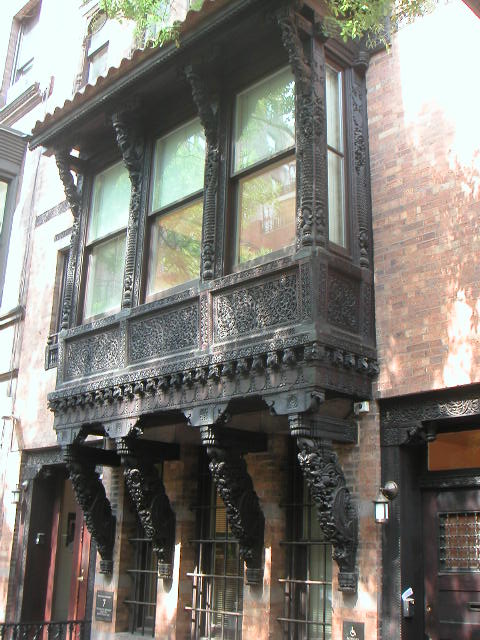  |
||||
|
images |
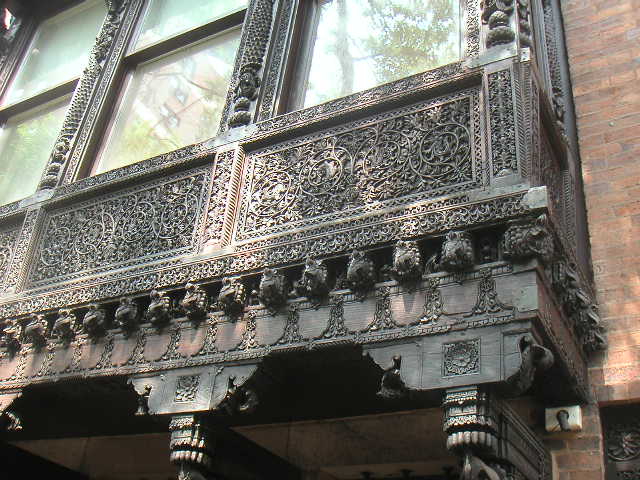 |
||||
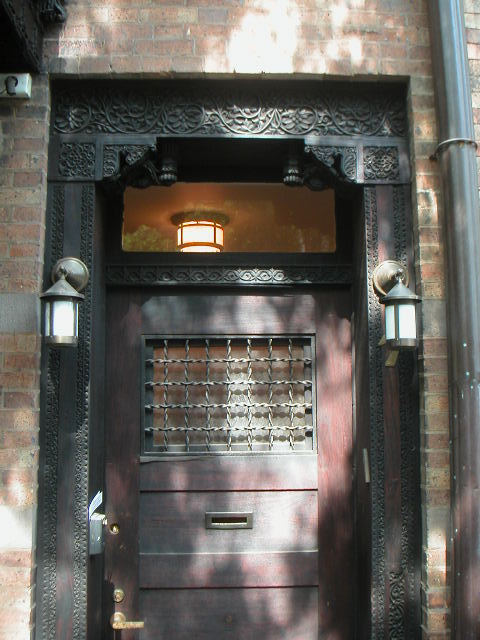 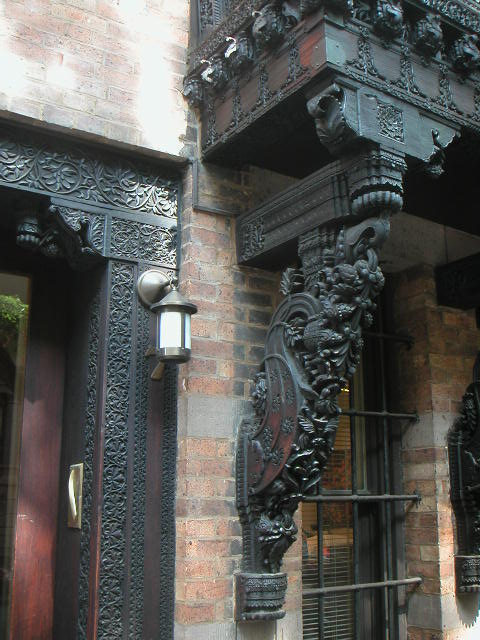 |
|||||
|
|
Streetscapes/The Ava, at 9
East 10th Street
The building, the Ava, is next door to a teak-encrusted private house at 7 East 10th Street built in 1887 by Lockwood de Forest, a prominent decorator of his day, and it is de Forest who was the man behind the teak. De Forest, who had worked with Louis Comfort Tiffany and other major artists, had a factory in India that shipped teak screens, doors and sometimes entire interiors to America, then a growing market for such exotica. He also had an extra lot next door, 9 East 10th, which he sold to the architect William H. Russell in 1888. Russell, who lived a block away at 21 West 10th Street, built the Ava, a five-story apartment house designed by his firm, Renwick, Aspinwall & Russell. For reasons that are not clear, Russell decided to use teak decoration on his building too, and the cornice and first-floor trim are in teak carved in a fashion extremely similar to that on the de Forest house -- the work must also have been from de Forest's factory.
Inside, the vestibule appears mostly intact, but the door and sidelights carry panes of glass unusually large for this period in such a location. Closer inspection indicates pin mounts at the top and locking devices at the bottom, as if some sort of rigid screen had been locked into place; tenants report that there has been nothing there for at least 30 years. There isn't enough depth in the frame for something made of iron; more likely it was some sort of wood that could be easily worked into a thin screen -- perhaps teak?
Later, as Greenwich Village became an artists' colony, it attracted people like Helen Dryden, who was described in The New York Times in 1956 as once having been the highest-paid female artist in the country. Dryden designed covers for Vogue and other journals, and did interiors for Studebaker automobiles. The 1925 census recorded her living at 9 East 10th Street with her 25-year-old Philippine-born cook and butler, Ricardo Lampitok. But by 1956 Dryden was living in a $10 a week hotel room paid for by the city's Welfare Department; at the time she referred nostalgically to her ''$200 a month'' 10th Street apartment. Dawn Powell was another artistic resident, in the 1930's and 40's. Tim Page, who has been involved in five books on the prolific diarist and author, said ''it was where she lived when her writing was strongest, where she finished books like 'Angels on Toast.' '' Mr. Page said that ''in a letter dated Sept. 16, 1931, Powell described the building as 'calm, spacious -- one's soul breathes deep breaths in it and feels at rest.' ''
The ground-floor entryway and hall have been spruced up with new woodwork and an interesting paint job. Jennifer Markowitz, the property manager, says that as rent-regulated apartments are decontrolled, ''we generally gut renovate, with modern fixtures and new sheet-rock ceilings and walls and new oak floors.'' Ms. Markowitz, who lives in a renovated apartment in the building, said that her apartment ''had some really nice detail, but it was so old it was dangerous.'' Nick and Amy Pearson's apartment, on the first floor in the rear, looks original, except for the bathrooms and kitchens. Most rooms have paneled ceilings, and there are three fireplaces in the six-room apartment, which has three-inch-wide pine-board floors. The finishes are characteristic of their period -- nothing museum quality, but old-shoe nice, with the sags and bumps of age. The Pearsons even have fragments of the original wallpaper showing under the peeling paint in their front hall. The fireplaces in the Pearsons' apartment are elegant but simple, with no teak. But in another tenant's apartment, on the front of the building, one fireplace is obviously teak, although its intricate carving has been painted over. It appears that no decorative-arts historian has surveyed the interiors of this unusual building. As to why Russell would have introduced something as unconventional as teak to what was just an investment, there is no better answer than Mrs. Pearson's: "Maybe it just made him sing, you know?" Photographs by Frances Roberts for The New York Times |
||||
|
notes |
This well-preserved facade with elaborate wood detailing was designed by Lockwood De Forest, one of the founding members of the Associated Artists, the decorative arts aetelier he co-founded with Louis Comfort Tiffany and Candace Wheeler in 1879. Inspired by his wedding trip to India, De Forest decorated the facade with low relief teak carvings produced in a Ahmedabad factory, particularly around the building’s main entry and the projecting oriel on the second floor. Widely admired for its decoration and furnishings, in 1900 a writer for House Beautiful called it the “most beautiful Indian House in America.” Purchased by New York University in the early 1990s, the building is currently occupied by the Bronfman Center for Jewish Student Life. | ||||
|
"...it will offer an opportunity for all groups on campus to become better acquainted with Jewish history, philosophy and theology and where other issues of general concern to the students can be explored and discussed." -- Edgar M. Bronfman
New York City (Dec. 5,) -- New York University will dedicate today (Thursday, Dec. 5, 1996) the Edgar M. Bronfman Center for Jewish Student Life, located at 7 East Tenth Street, in the heart of NYU's Greenwich Village campus. The dedication ceremonies will begin at 5:00 p.m. Television and print coverage is welcome. Please call 212/998-6849 or 212/ 998-6848 to make a press reservation. "We, at New York University," said Laurence Tisch, chairman of the NYU Board of Trustees, "are grateful to Edgar Bronfman for making this Center for Jewish Student Life possible. His recognition that the college campus provides an important place where Jewish students can explore the meaning and relevancy of Judaism today and his willingness to give financial support, as well as time and personal effort, to provide such opportunities on campuses throughout the country is a major contribution to the Jewish community." The NYU Bronfman Center, purchased with a $2.5 million gift from Mr. Bronfman, was formerly the Lockwood de Forest house, described by a writer at the turn of the century as the "most Indian house in America" and one of the most beautiful buildings in New York City. It has been painstakingly renovated to preserve its historic interior and exterior and remains one of the most interesting townhouses in New York. The building itself is five stories, with lounges, conference rooms, study areas, computer and recreational areas, and space for quiet contemplation, discussion, the exchange of ideas and worship. The building will be used not only for Jewish students, but also for other student programs within NYU. "I join Laurence Tisch," added Dr. L. Jay Oliva, President of NYU, "in applauding and thanking Edgar Bronfman for this magnanimous gift to New York University, which fills so important a need at NYU. We are especially pleased that the Center has been named for Mr. Bronfman, whose name is synonymous with community service, philanthropy, education, the struggle for Jewish survival and for equality, civil rights and social justice for all. I have no doubt that the Bronfman Center will become a place where each person, regardless of affiliation or belief, will feel welcome -- and where meetings, conferences, discussions and interpersonal exchanges will educate, stimulate and enrich our students." In response, Mr. Bronfman stated his pleasure at having the "opportunity to provide a Jewish center at New York University where Jewish young people can explore their roots, understand their heritage and find meaning in their Jewishness. I hope, too, it will offer an opportunity for all groups on campus to become better acquainted with Jewish history, philosophy and theology and where other issues of general concern to the students can be explored and discussed." Studies have shown that Jewish education before bar mitzvah years has only a limited impact on encouraging Jews to remain Jewish. The greatest impact is derived from "association behavior" -- attendance at Jewish camps; participation in Jewish teenage groups; membership in Hillel at college or even taking a single Jewish course. The Bronfman Center has been created to meet that need. The Bronfman Center will work closely with Hillel. It will be supervised by an Advisory Board co-chaired by Professor Robert Chazan, chairman of the NYU Department of Hebrew and Judaic Studies, and by Senior Vice President Naomi Levine. The Board consists of many distinguished leaders and thinkers in the Jewish community and several scholars such as Dr. Lawrence Schiffman, the Ethel and Irwin A. Edelman Professor of Hebrew and Judaic Studies; and Dr. Arthur Hertzberg, the Bronfman Visiting Professor of Humanities in the Department of History. Both Professors Schiffman and Hertzberg played important roles in creating the Center. Dr. Susan F. Dickman has been named the Executive Director of the Bronfman Center for Jewish Student Life. The Center will report to the Office of Student Affairs at NYU. "In this way," explained co-chairman Naomi Levine, "it will be part and parcel of student activities at New York University. It will also act as a bridge to other institutions in the Greenwich Village area, providing programs and activities for the entire community." The renovation of the de Forest house was done by the firm of Helpern Associates, who undertook their task, and accomplished it, with great respect for the building's historic past. In addition to Mr. Bronfman, additional funding for the Bronfman Center has come from the Skirball Foundation, the Jewish Culture Foundation and trustees of NYU, including: Diane Belfer, Morris Bergreen, Alan Greenberg, George Heyman, Helen Kimmel, Martin Lipton, Larry Silverstein, Sheldon Solow, Leonard Stern, Henry Taub and Laurence Tisch.
1.Where is the Bronfman Center located?
1.What are the hours of operation? 2.
What is the Jewish community like at NYU? 3. I
am not religious or Jewish, or an NYU student can I stll participate? 4. I
am interested in arts & Culture – what does the Bronfman Center offer? 5. I
am interested in community service – what does the Bronfman Center
offer? 6. I
am interested in Israel – what does the Bronfman Center offer? 7.
How do I get in touch with a rabbi? * Rabbi Andrew
Bachman, Director, rabbi.bachman@nyu.edu, 212.998.4110
9.
Are there specific programs available for Graduate Students and Young
Professionals? 10.
What options are available for religious services? 11.
What sort of options are available for Kosher Food? 13. I
want a Jewish Roommate – what should I do? 13.
What is the history of the Lockwood deForest House? |
|||||